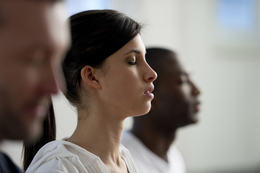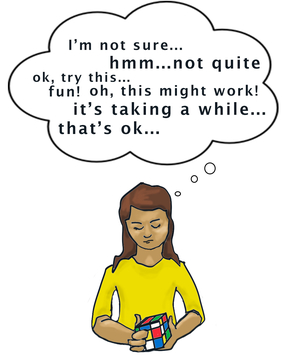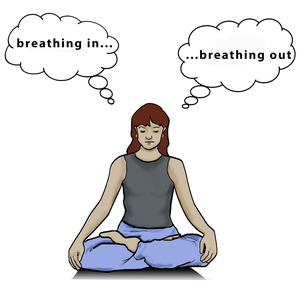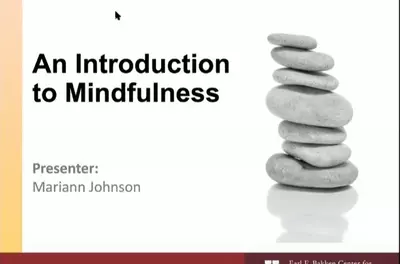What Is Mindfulness?

 “Mindfulness is awareness that arises through paying attention, on purpose, in the present moment, and non-judgmentally.”
“Mindfulness is awareness that arises through paying attention, on purpose, in the present moment, and non-judgmentally.”
This is the oft-cited definition from Jon Kabat-Zinn, well-known author and founder of the Stress Reduction Clinic at the University of Massachusetts (who is careful to add that it is an operational definition and leaves out some aspects of mindfulness).
A similar definition comes from psychologist Scott Bishop, who describes mindfulness as a “nonelaborative, nonjudgmental, present-centered awareness in which each thought, feeling, sensation that arises ... is acknowledged and accepted as it is.”
Simple as it may sound, mindfulness transforms how we relate to events and experiences. It creates a more spacious way of being in the world that is less reactive and generally happier.
Mindfulness is different from our default mode
Developing a steady and non-reactive attention is often radically different from the way we are in the world.
Many of us spend large parts of our lives on auto pilot, not aware of what we are experiencing, missing out on all the sights and sounds and smells and connections and joys we could appreciate. Some of that time our minds seem "switched off," and other times caught in thoughts from the past (often regrets) or plans for the future, much of which is repetitive.
When we do notice something in the present, our habit is often to judge instantly and react quickly, often working from a faulty or limited perspective that restricts our options or creates issues.
Mindfulness helps us be present in our lives and gives us some control over our reactions and repetitive thought patterns. It helps us pause, get a clearer picture of a situation, and respond more skillfully.
Compare your default mode with a mindful state
 Consider how you react when you don’t think you are good at something: say solving brain teasers. When you are presented with a brain teaser, what do you do? Do you tell yourself, “I am not good at this,” or “I am going to look stupid”? Does this distract you from paying attention to working on the puzzle?
Consider how you react when you don’t think you are good at something: say solving brain teasers. When you are presented with a brain teaser, what do you do? Do you tell yourself, “I am not good at this,” or “I am going to look stupid”? Does this distract you from paying attention to working on the puzzle?
How it might be different if you had an open attitude with no concern or judgment about performance, just a curiosity about how working on the brain teaser might be? What if you directly experienced the process as it unfolded—the challenges, anxieties, insights, accomplishments—acknowledging each thought or feeling and accepting it without needing to figure it out or explore it further.
If you do this with some regularity, you start to see the habitual patterns that lead you to react automatically in negative or unhelpful ways and create stress. By observing instead of reacting, you develop a broader perspective and can choose a more effective response.
You can develop mindfulness in different ways
If mindfulness is a different state than our normal default way of being, how can we develop it? There are many different practices that can support the development of mindfulness, including different types of sitting meditation, movement, or even simply being in nature. This site describes some of these mindfulness meditation techniques. In general, they seek to develop three key characteristics of mindfulness:
- Intention to cultivate awareness (and return to it again and again)
- Attention to what is occurring in the present moment (simply observing thoughts, feelings, sensations as they arise)
- Attitude that is non-judgmental, curious, and kind
Watch this animation to learn more about how these characteristics interact and support each other.
What is mindfulness meditation like?
 Sara, who has been practicing mindfulness meditation for several years, describes her typical practice.
Sara, who has been practicing mindfulness meditation for several years, describes her typical practice.
“I sit in an upright posture, usually on a cushion or bench on the floor, but sometimes in a chair when my knees or back are bothering me. I usually pay attention to the sensations of breathing in and out. (Sometimes I tune into sounds or body sensations, but mostly when I am sitting I notice my breath.)
Whenever my attention wanders from my breathing to thoughts and feelings that pop up, I just acknowledge that those thoughts or feelings are present right now, and then gently return to my breath. Noticing the thoughts or feelings is actually a moment of mindfulness!
This practice isn’t always easy—sometimes I get lost in my thoughts for a long time, but eventually I notice I am lost, and I go back to my breath.”
There is no one right way to practice
Sara’s practice—awareness of breathing—is one of the most common ways to develop mindfulness, but there is no one “right” practice. Other practices might place the attention on sensations in the body, or sounds, or even an open awareness of whatever is arising. All of these help develop a steady attention that is firmly grounded in the present moment.
Mindfulness is not always easy because other experiences (thoughts, feelings, physical discomfort) naturally arise and can pull our attention away. But with practice, our skill increases, and we can pay attention to our chosen object without getting lost in other experiences. And we find that we can also simultaneously notice any underlying reactivity, such as annoyance or frustration.

Guided meditation
Try this short, 1-minute guided audio for a taste of meditation.

Free webinar
Mariann Johnson, an MBSR instructor and mindfulness practitioner for over 25 years, gives more tips on how to practice.
Why practice mindfulness?
Learn more about the benefits of mindfulnessFor some people, mindfulness is primarily a way to enhance health or performance. For others, mindfulness is a tool for self-exploration. And for yet others, mindfulness is part of a spiritual path, a way to develop insight into the human condition and freedom from suffering.
Regardless of the motivation, scientists find that practicing mindfulness is associated with changes in the structure and function of the brain as well as changes in our physiological responses to stress, suggesting that this practice has important impacts on our physical and emotional health that are worth exploring.
Where does mindfulness come from?
While there are many different techniques for practicing meditation, the practices that cultivate mindfulness originally come from a more than 2,500 year-old Buddhist tradition. As the West came into contact with these practices from the East, they were taught from within the traditional Buddhist context, as well as adapted into a secular context that did not incorporate the original cultural or doctrinal elements.
Twenty years ago, a person interested in mindfulness was more likely to find a Buddhist-based offering than a secular mindfulness program. Nowadays, the reverse is true. One of the oldest of these secular offerings is Mindfulness-Based Stress Reduction (see box below).
What is Mindfulness Based Stress Reduction?
Mindfulness Based Stress Reduction (MBSR) is an eight-week program that teaches mindfulness from a secular perspective. It was originally developed by Dr. Jon Kabat-Zinn at the University of Massachusetts Medical Center to help patients who were dealing with pain and other conditions.
MBSR is now widely taught in hospitals, as well as non-medical settings, such as schools, prisons, athletic training programs, and the workplace. It is often used in research studies that seek to assess the impact of mindfulness.
Watch our webinar about MBSR Program History, Evolution, and Possible Benefits.

Are there other mindfulness-based interventions?
Since MBSR was first offered in 1979, a number of other mindfulness-based interventions have been developed. The one most often mentioned in research studies is Mindfulness Based Cognitive Therapy, which blends mindfulness techniques with traditional cognitive behavioral therapy.
Try Mindful Mondays
Free drop-in sessions held on Zoom from noon to 1 p.m. Central.

Bishop, S. (2004). Mindfulness: A Proposed Operational Definition. Clinical Psychology: Science and Practice, V11 N3.
Blair, L. (2015 July 06). Mind healing: Mindfulness can let you down.Telegraph. http://www.telegraph.co.uk/lifestyle/wellbeing/mood-mind/11713946/Mind-Healing-Mindfulness-can-let-you-down.html
Brendel, D. (2015 Feb 11). There are risks to mindfulness at work. Harvard Business Review. https://hbr.org/2015/02/there-are-risks-to-mindfulness-at-work
Center for Mindfulness http://www.umassmed.edu/cfm/stress-reduction/history-of-mbsr/
CBC Radio. (2015 June 12). Can mindfulness meditation have negative side effects? http://www.cbc.ca/radio/day6/episode-237-the-cost-of-the-senate-audit-the-cheater-s-high-parkour-prison-breaks-more-1.3109635/can-mindfulness-meditation-have-negative-side-effects-1.3109670
Cooper, A. (2014 Dec 13). Mindfulness. 60 Minutes. http://www.cbsnews.com/news/mindfulness-anderson-cooper-60-minutes/
Derby, D. (2014 Feb 23). Should we be mindful of mindfulness? The Guardian. http://www.theguardian.com/society/2014/feb/23/should-we-be-mindful-of-mindfulness-nhs-depression
Kabat-Zinn, J. (1990). Full Catastrophe Living. New York: Random House.
Kornfield, J. (2008). The Wise Heart. New York: Bantam Books.
Richards, C. (2014 Sept 29). Being mindful can help guide a decision. The New York Times. http://www.nytimes.com/2014/09/29/your-money/being-mindful-can-help-guide-a-decision.html
Sander, S., Lee, J. (2015 July 01). Olympic medalist Deena Kastor shares 10 mindfulness tips for world record success, health and happiness. Huffington Post. http://www.huffingtonpost.com/michael-sandler-and-jessica-lee/10-ways-runner-olympian-d_b_7649238.html



